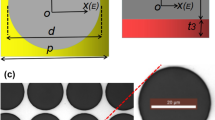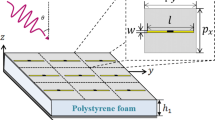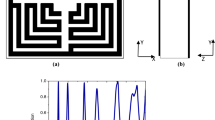Abstract
Here we present the experimental study of spectral properties of specials metamaterials, formed by periodical composite structures/devices. The numerical analysis of their spectra is performed. The possibility to design magnetically tunable THz-GHz band passive elements based on the given metamaterials is under discussion.
Access provided by Autonomous University of Puebla. Download conference paper PDF
Similar content being viewed by others
Keywords
These keywords were added by machine and not by the authors. This process is experimental and the keywords may be updated as the learning algorithm improves.
23.1 Introduction
We used two approaches for the development, research and usage of artificial media for needs of technology at GHz-THz band. Note that the artificial medium under discussion is presented by various elements, located periodically in the space. Thus
(I)-approach uses the principles of wave propagation through the special types of artificial medium such as periodical structures [1–4] (photonic crystals, PC). As it is well known, forbidden and allowed zones arise in the transmission spectrum of such structures. Both the frequency position and width of these zones can be varied with external magnetic field [2], if some elements of PC are magnetically dependent.
(II)-approach uses the principles of wave propagation through the artificial media with non-homogeneities that are much smaller than the wavelength. Therefore effective constitutive parameters of such a medium can be either positive or negative, dependently on certain internal (permittivity, permeability, etc.) and external (magnetic field, temperature, etc.) parameters [5, 6].
23.2 Experiment and Results
The typical structure, performed as a basis of passive devices intended for study of the corresponding physics processes is shown in Fig. 23.1. It is formed by the periodically situated plates of various materials, placed into the hollow metal waveguide. If the external magnetic field is applied, the optical length is changed. So, the spectral zone structure is changed also [1, 2, 5]. For the wavelengths comparable with the dimension of the structure element we have (I)-situation ((I)-approach). For the wavelengths much larger than the dimension of the structure element we have (II)-situation ((II)-approach).
In spite of the fact that our experiments have been performed in GHz band [2, 4, 5, 7, 8], we have found the conditions, that provide the control of spectral properties of the structures up to THz, both analytically and numerically.
During experiments a number of various unit cells were used to form one-dimension (1D) photonic crystals and other artificial media (Fig. 23.1). These are the elements:
-
with non-varied constitutive parameters: quartz; polystyrene; teflon; copper-thin-film-medium; copper-wire-medium etc.;
-
with magnetic-field-varied constitutive parameters: ferrite; Co-Fe-Ni-wire-medium [6]; La-Sr-Mn-O layers [5]; semiconductor-InSb layers [8] etc.
As a rule such 1D photonic crystals are located in the single-mode metal hollow waveguide.
The main experimental result of the (I)-approach is the possibility to control the forbidden/allowed zones [2, 4].
A very promising application of the band structure of spectrum seems to be its usage for the definition of constitutive parameters of metamaterials. The method can be illustrated (Fig. 23.2) by measuring the permittivity of nanostructure based on the opal matrix with ferrimagnetic inclusions Ni0.5Zn0.5Fe2O4 as a test medium. The specimen of opal matrix is a natural magneto-photonic crystal (MPC) for optical range [7]. However, in the millimeter waveband it should be considered as a certain medium with averaged constitutive parameters i.e. – metamaterial.
Thus the one-dimensional periodic structure (1D microwave MPC) for millimeter range (20–40 GHz) has been made (Fig. 23.2(a)) [2, 3]. Its double-layered unit cell includes both the specimen under study and the specimen with known constitutive parameters (ε and μ). In our case the considered specimen is the mentioned above opal matrix with ferrite (optic MPC); the specimen with known parameters is the teflon layer. So such composite structure, that is a microwave magnetophotonic crystal, demonstrates the band-structured spectrum in the millimeter range (Fig. 23.2(a)). The band structure of this microwave MPC has been detected experimentally.
After that the band structure was calculated numerically (using a known method of transfer matrixes [1]). The model for calculation includes both complex permeability μ and permittivity ε and for all elements forming the unit cell of MPC. By selection the pair of the values included in the product (μ ⋅ε) for the investigating material, we achieve the best coincidence between experimental and theoretical band structures of spectra (Fig. 23.2(b)). If we suppose that μ′ = 1 (that is true for zero external magnetic field) than ε can be defined.
The band structure of the microwave MPC obtained experimentally and numerically is showed in Fig. 23.2(b). The magnitude ε′ = 2. 7 for Ni0.5Zn0.5Fe2O4 has been found. The accuracy of the technique reaches 3-5%.
Probably the most promising result of this cycle is the appearance of the surface oscillations, which manifest themselves as a quite narrow peak in the stopband of spectrum for the case when some special non-homogeneity is joined to the boundary of PC. In this case the peak, known as Tamm-peak [3, 4, 6] appears (Fig. 23.3(a)). This peak has other origin than the spectra zones. Therefore it has quite high Q-factor. Moreover it demonstrates sufficiently more strong dependence on the external magnetic field than MPC-zones.
(Color online) (a) – Tamm peak, appeared in the forbidden zone of PC – (red solid arrow) [5]; (b) – DNG-peak (blue dashed arrow) moving toward the Tamm peak with H-field increasing
This is the reason, why surface oscillations become quite promising for design of electronically controlled devices. Let us note that a lot of reasons can excite Tamm oscillations. Among them there are: conductivity, magnetic and electric losses, spatial defects, polarization non-homogeneity, constitutive parameters’ non-homogeneity, etc. Therefore a lot of possibilities to vary the frequency position and Q-factor of these oscillations exist.
However it seems, that the most prospective today is the combination of both (I) and (II) approaches. This allows to find not only the Tamm peaks, but as well the additional peaks, caused by appearance of high-transparent zones in their spectra. These so-called Double-Negative (DNG)-zones (the blue dashed arrow in Fig. 23.3(b), [5]) can be excited when PC contacts with the left-handed medium (LHM) [5, 6].
Here one has broad possibilities to form such left-handed artificial media, using various special structures. Namely one can use the natural nanostructure, for example, the lanthanum-doped manganite-perovskite, (Fig. 23.1(b), see in details [5], and as well an artificial ones (ferrite/semiconductor, ferrite/wire-medium, Fig. 23.4(a) and (b). These structures, that demonstrate both negative permittivity and permeability for some frequency band, can be calculated, designed and manufactured for wide frequency band from GHz up to THz.
The composite structure presented in Fig. 23.4(a) (see in details [6]) is formed by alternating ferrite and wire medium layers. The structure has been studied both numerically and experimentally. Due to the thickness of the layers of ferrite and wire medium that are much less than the wavelength, a DNG-zone with the width δf ≈ 2 GHz appears in the spectra of such composite structure.
A cycle of calculations have been performed in order to elaborate the design of another one structure. It is shown in Fig. 23.4(b) and it is formed by the set of alternating rectangular bricks of ferrite and semiconductor InSb (0. 25 ×0. 5 ×3. 4 mm3) oriented in staggered order (chessboard order). The bricks are placed into the single mode rectangular metal hollow waveguide. The ferrite bricks have negative permeability in the vicinity of its magnetic resonance. The InSb bricks represent a negative permittivity material, because they possess a quite large carriers concentration.
One can see easily from the spectra in Fig. 23.5(a) that the typical DNG peak appears in the stopband. The spatial electromagnetic field density distribution for the DNG-peak frequency is shown in Fig. 23.5(b). The medium demonstrates a quite high transparency here. At the same time, the backward wave appears inside the specimen, confirming the left-handed behavior of the structure. Let us note, that in this case two DNG-zones but not one (and correspondingly two DNG-peaks) can appear. They are marked as “1” and “2” in Fig. 23.5(a). The origin of this phenomenon is quite simple. It is connected with the non-symmetry of the position of chessboard structure, inserted into waveguide.
So, the oscillations in the left handed medium (DNG-peaks, DNG-zones) seem to be quite promising for further application due to their rather high quality factor and their strong dependence of the external parameters.
23.3 Conclusions
Thus, some certain intrinsic features of 1D metamaterials (namely PC and left-handed media) formed by natural materials have been analyzed in the given paper. Experiments that are performed in microwave band demonstrated their applicability and effectiveness for design of magnetically tunable passive electronic devices of GHz-band.
To sum up, as we can simulate the physical features of various artificial media, we can study a lot of questions devoted to the technology features of THz passive devices using experiments in GHz-band, where the technological processes are much cheaper, than in THz-band.
Let us note that we can transfer the results to the higher frequency range as far as we know the dispersion law for the elements forming the structure.
References
Born M, Volf E, 1968 Principles of Optics (Oxford: Pergamon Press).
S. Chernovtsev, D. Belozorov, S. Tarapov, Magnetically controllable 1D magnetophotonic crystal in millimeter wavelength band, J.Phys.D: Appl.Phys. vol 40, pp.295-299, 2007.
Vinogradov A, Dorofeenko A, Erokhin S, Inoue M et al 2006 Phys.Rev B 74 045128.
D.P. Belozorov, M.K. Khodzitsky, S.I. Tarapov, Tamm states in magnetophotonic crystals and permittivity of the wire medium, J.Phys.D:Appl.Phys., vol 42, pp055003(1-5), 2009.
M. K. Khodzitsky, T. V. Kalmykova, S. I. Tarapov, D. P. Belozorov, A. M. Pogorily, Left-handed behavior of strontium-doped lanthanum manganite in the millimeter waveband, Appl. Phys. Letters, vol. 95, pp.082903(1-3), 2009.
M. Khodzitsky, A. Kharchenko, A. Strashevskyi, S. Tarapov, Left-Handed Properties of Metal-Ferrite Composites Placed into Waveguide in Millimetric Wave Range, Telecommunications and Radio Engineering, v. 68, N7, p.561-566, 2009.
M.I. Samoylovich, Nanomaterials, TEKHNOMASH, 2007 (in Rus.).
A.A. Bulgakov, A.A.Girich, M.K.Khodzitsky, O.V.Shramkova, S.I.Tarapov, Transmission of electromagnetic waves in a magnetic fine-stratified structure, Journal of the Opt. Soc. of Am. B (JOSA B:Optical Physics), v. 26, N12, p.156-160, 2009.
Acknowledgements
Authors are grateful to Prof. M. Samoylovich (CSITI “TEKHNOMASH”, Russia); Prof. A. Pogorily and Prof. A. Tovstolitkin (Imag NASU, Ukraine), Prof. A. Belous (IGNC NASU, Ukraine) for kindly given samples. Research is supported partially by the STCU grants #4912, #5210.
Author information
Authors and Affiliations
Corresponding author
Editor information
Editors and Affiliations
Rights and permissions
Copyright information
© 2011 Springer Science+Business Media B.V.
About this paper
Cite this paper
Girich, A., Khodzitsky, M., Nedukh, S., Tarapov, S. (2011). Experimental Analysis of Metamaterials’ Spectra to Design Tunable THz-GHz Passive Devices. In: Pereira, M., Shulika, O. (eds) Terahertz and Mid Infrared Radiation. NATO Science for Peace and Security Series B: Physics and Biophysics. Springer, Dordrecht. https://doi.org/10.1007/978-94-007-0769-6_23
Download citation
DOI: https://doi.org/10.1007/978-94-007-0769-6_23
Published:
Publisher Name: Springer, Dordrecht
Print ISBN: 978-94-007-0768-9
Online ISBN: 978-94-007-0769-6
eBook Packages: Physics and AstronomyPhysics and Astronomy (R0)









